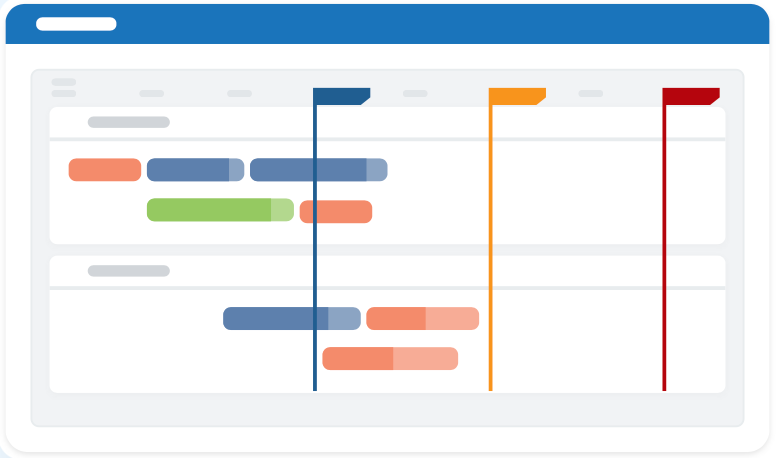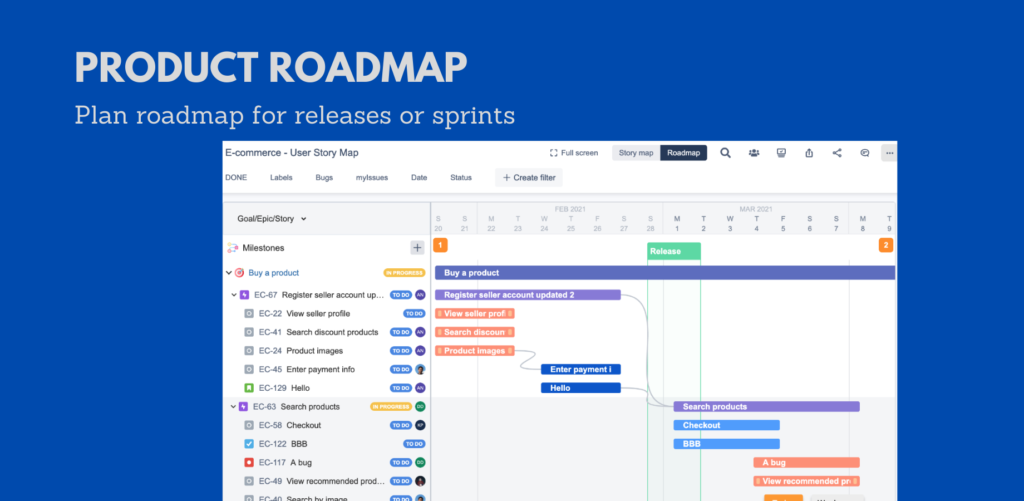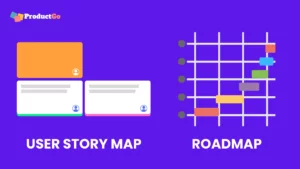The essence of Agile may not go hand in hand with product roadmaps at first glance. Yet, they have become a valuable tool to Agile teams for finding the right balance between flexibility and time-critical business needs. In contrast to Agile components like backlogs and user story maps that focus on development tactics, roadmaps help you strategize how to attract customers and fulfill business goals in a competitive market.
As a tool often used to plan milestones and product releases, creating roadmaps that allow products to evolve along with market trends is crucial to the success of an Agile development process. Luckily, with the help of the right ideas and technology, designing a solid roadmap for your product doesn’t take much effort.
Table of Contents
What is a product roadmap?

Whether it’s tied to Agile or Waterfall development, a product roadmap is a high-level visualization of the planned evolution of a product. It helps you realize and prioritize your goals for upcoming releases and roughly layout the product’s future direction.
Unlike project backlogs that emphasize product features and functions, roadmaps work as a strategic tool that draws from the bigger picture surrounding releasing a product into a competitive market. Due to this, creating product roadmaps becomes a balancing act between accounting for market trajectories and customer needs and engineering constraints.
Agile vs. Waterfall product roadmaps
Since its early days, product roadmaps have been a core part of the Waterfall development methodology. However, roadmaps created in Waterfall follow a rigid structure that offers limited flexibility to adapt to evolving data and trends. In contrast, Agile roadmaps leave room for adjusting to short to long-term plans based on stakeholder feedback and shifting market tendencies.
Rigid planning of Waterfall roadmaps comes at the cost of substantial upfront investments that complicate correcting ineffective decisions during the development process. While Agile roadmaps rarely run into this problem, they are not without their pain points. Making too many changes to the roadmap, for example, can destabilize the development process and demotivate the team. Hesitating to make changes at the right time, on the other hand, might lead to lagging behind your competitors. While learning how to avoid such pitfalls is something that comes with experience and experimentation, quarterly reviews are a good place to start for most products.
How to create a roadmap for your product

Step 1: Develop the product vision and strategy
Establishing the product’s vision and strategy early on is essential for developing a strategic plan for its evolution. Here, the product vision refers to the positive change your product is expected to bring. Product’s value proposition is invaluable for identifying its vision.
On the other hand, product strategy requires careful consideration of three key areas, according to Roman Pichler:
- Market and needs: Who your customers are, their needs, and how your product addresses these needs.
- Business goals: The company’s expectations for the product. It could be generating revenue, promoting another product, etc.
- Key features: 3-5 key features that help the product stand out over the competition.
Once you have identified the product vision and strategy, you’ll have a better understanding of the road it could take to satisfy both customers and the business.
Step 2: Identify product goals
With the vision and strategy set, you can now identify the goals the product should achieve to impact the market as expected. It would be ideal to consider short to long-term goals in this step.
Since the long-term future of an Agile development process that adjusts to shifting strategic needs is difficult to predict, identified long-term goals could remain as vague and abstract as necessary. Short to mid-term goals have more room to be specific and carry timelines.
Step 3: Identify key milestones and releases
Having a clear set of goals allows you to identify the key milestones the product should reach within a certain period and prepare release timelines. Each milestone or release you add to the roadmap should have the following attributes defined.
- Milestone/release name
- Timeline
- Product goals to achieve before reaching the milestone/release point
- Metrics used to measure the performance within the period
- Key features that should be implemented to reach the intended goals
Step 4: Create the roadmap
Now, it’s time to visualize the roadmap using the releases, milestones, and goals identified in previous steps. You can use vertical lines to indicate milestones and releases with deadlines. Goals belonging to each timeline, which we call initiatives, can be placed in their relevant positions along the horizontal axis. You can also divide the roadmap into three sections, now, next, and later, along the horizontal axis to separate short, mid, and long-term initiatives.
Step 5: Connect the roadmap with the product backlog
You can now connect the product roadmap you’ve built with the larger context behind an Agile process that includes product backlogs, user story maps, and Agile boards. It’s easy to establish this connection using the key features you listed in step 3 under each goal/initiative: you can link the epics and user stories associated with each feature to the initiative it fulfills. This process allows you to derive which work needs to be completed before a particular release, milestone, or a deadline and plan your sprints accordingly.
Step 6: Periodically review the roadmap
Once you’ve drawn up the initial product roadmap, maintaining and adjusting it based on shifting market needs becomes an ongoing process. You can incorporate data collected from market surveys, customer feedback, usability testing, user data analysis, and forecasts to understand how the product should modify its future direction to stay ahead of the competition while satisfying customers.
The ideal timeframe for a roadmap review depends on the unique qualities of the product and market. A highly volatile market will require monthly roadmap reviews, while quarterly reviews will suffice the others.
How drastically your roadmap will have to change also depends on these shifting circumstances. Sometimes a review will only adjust the timelines and modify several initiatives. Other times, you’ll have to redo every step from building the product strategy.
Key points to consider when creating a roadmap
There are several key points you should bear in mind while creating a roadmap.
- Focus on the product and business goals you want to achieve rather than specific features and functions. It allows you to drive the development based on outcomes instead of work done.
- Assign priorities to each goal to ensure you hit at least the minimum required targets within a period.
- Keep the roadmap as simple as possible. Don’t give in to the temptation to add more and more initiatives and complicate the map.
- Collaborate with the stakeholders while creating the roadmap and actively seek their feedback during review sessions.
- Include metrics and KPIs to ensure the progress of your roadmap is measurable.
- Have a rough idea about which teams will be working on different initiatives when adding them to the roadmap.
- Take dependencies a team working on a certain initiative may have on other initiatives and teams into consideration when developing timelines.
How to ensure stakeholder collaboration during roadmap creation
Considering how a roadmap impacts a product’s future direction, you should ensure the participation of all stakeholders during the designing process. The ideal solution would be to gather all the stakeholders in one place before the process starts. But it’s not always practical given how roadmap reviews occur as frequently as once a month/quarter. That’s why you need the assistance of modern technology to make roadmap creation a collaborative process.
If you’re already using Jira for all your Agile development tasks, collaborating on product roadmaps and connecting them to the larger Agile context is now a hassle-free job with the integration of our Agile Story Map & Product Roadmap for Jira application. We provide a Gantt-like, interactive timeline to visualize your roadmap for better comprehension. With the app’s built-in story mapping capabilities, you can easily connect your roadmaps and user story maps to plan sprints and releases accordingly to achieve your business goals.
Wrapping up
Product roadmaps are as essential to Agile teams as they are to Waterfall teams as a tool of visualizing how a product is expected to evolve over time. At the same time, Agile roadmaps leave enough room for course corrections depending on shifting market tendencies. Finding the right balance between too much rigidity and too much flexibility in a roadmap is key to the success of an Agile team in the long term. Hopefully, with the right tools and technology, you’ll be able to reach that point sooner and develop products that can thrive even in unpredictable markets.












